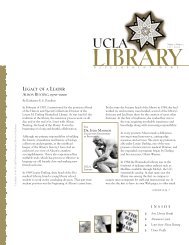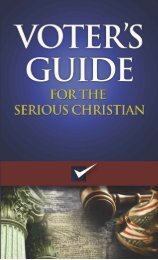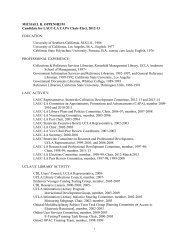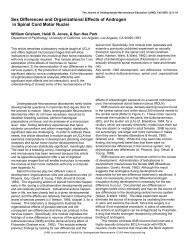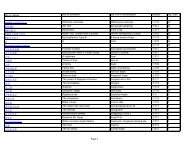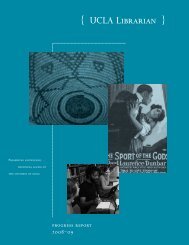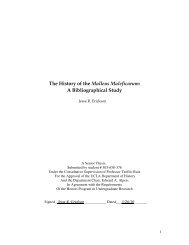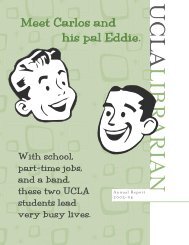Research Paper - UCLA Library
Research Paper - UCLA Library
Research Paper - UCLA Library
You also want an ePaper? Increase the reach of your titles
YUMPU automatically turns print PDFs into web optimized ePapers that Google loves.
prevented” (Nichols 26). “Their long feared danger” must have referred to the long existing<br />
tensions over the past decade regarding what would happen to England after Elizabeth’s death.<br />
The War of the Roses, which had installed the Tudor dynasty onto the throne of England, had<br />
Gu 18<br />
only occurred less than two generations ago and the concept of another civil war kept the people<br />
at a general unease.<br />
The new regime encouraged a reversion to traditional masculine models of rule, and<br />
literary representations of power soon followed. Although the late sixteenth and early<br />
seventeenth century had seen a rise in female rulers – from Mary and Elizabeth Tudor to Mary,<br />
Queen of Scots in Scotland and Catherine de’ Medici in France – queenship was still regarded as<br />
an anomaly and a threat to patriarchal society. Kirilka Stavreva makes the argument that several<br />
of Shakespeare’s Jacobean plays align queenship with witchcraft, portraying queens as<br />
dangerous and evil. Historically, the fascination with witches may have come out “on the heels<br />
of witchcraft trials in the last decades of Queen Elizabeth’s reign,” but the association of<br />
witchcraft with queens undermines female authority and the concept of women as good rulers<br />
(Stavreva 152). Although Stavreva only deals with Macbeth and Cymbeline, the connection<br />
between queenship and witchcraft is a useful indication of seventeenth century misogyny and<br />
fears surrounding female rule. This type of misogyny was furthered by the queens themselves,<br />
who preferred to refer to themselves as “King” in order to maintain the authority that came with<br />
masculinity, or as Mortimer Levine suggests, to become “males, for the purpose of ruling”<br />
(Hopkins 30). 7 These misogynistic perspectives on women and queenship make specious the<br />
assertion for blind adoration and nostalgia for a female ruler in a patriarchal society.<br />
7 For the way in which Elizabeth herself gendered herself as male, see Carole Levin’s “The Heart and Stomach of a<br />
King”: Elizabeth I and the Politics of Sex and Power (Philadelphia: U of Pennsylvania P, 1994).



